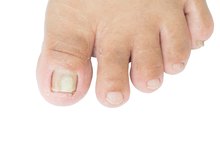DMSO for Nail Fungus
DMSO, or dimethyl sulfoxide, is a natural byproduct of the wood industry. It is a colorless liquid derived from lignin, which is the material that binds together the cells of trees. DMSO is well-studied and has proven to be nontoxic, but it’s controversial because some health practitioners recommend it for treating serious illnesses, such as cancer. Although not approved to treat cancer, DMSO displays penetrating properties that may be useful for treating nail fungus. Consult with your doctor before combining DMSO with any medications or anti-fungal applications.
If you are experiencing serious medical symptoms, seek emergency treatment immediately.
DMSO Properties
DMSO has been used as a commercial solvent since the early 1950s because it dissolves material well. According to “Human Biochemistry and Disease,” DMSO was first investigated as a potential health remedy in 1961 when Dr. Stanley Jacob, an organ transplant specialist, discovered that it penetrates the skin, membranes and other connective tissues quickly and deeply without damaging it 1. Dr. Jacob eventually discovered that a 70 to 90 percent solution of DMSO works best and he often mixed it with herbal remedies and pharmaceuticals to help drive them deeper into the body where they could reach infections. In addition to its penetrating ability, DMSO displays anti-inflammatory, antioxidant and analgesic properties. Thousands of studies have been conducted on DMSO, and it was eventually approved by the U.S. Food and Drug Administration for use as an organ transplant preservative and for interstitial cystitis, a bladder disease, as cited in “Medical Herbalism.”
- DMSO has been used as a commercial solvent since the early 1950s because it dissolves material well.
- According to “Human Biochemistry and Disease,” DMSO was first investigated as a potential health remedy in 1961 when Dr. Stanley Jacob, an organ transplant specialist, discovered that it penetrates the skin, membranes and other connective tissues quickly and deeply without damaging it 1.
Nail Fungus
Herbs That Remove Toxins or Bacterial Infections From the Body
Learn More
Fungal infection of your toenails or finger nails is called onychomycosis, which causes yellow or brown nail discoloration and damage. Nail fungus, which is commonly caused by Candida species, can make your nails thick, crumbly and prone to breaking. Once fungus gets into your nail beds it can be very difficult to treat because it penetrates the tissue deeply. Anti-fungal medications can be taken orally or applied as ointments, but they must be used consistently for many weeks to be effective, and long-term use of any drug can lead to side effects. Many natural herbal remedies display anti-fungal properties, but they often cannot penetrate your nail beds to kill all of the fungus.
- Fungal infection of your toenails or finger nails is called onychomycosis, which causes yellow or brown nail discoloration and damage.
- Many natural herbal remedies display anti-fungal properties, but they often cannot penetrate your nail beds to kill all of the fungus.
DMSO and Fungus
DMSO is not recognized as an anti-fungal, but it can be combined with anti-fungal chemicals or herbal remedies to drive them through your nail beds to where the fungus is proliferating and destroying tissue. According to “The New Healing Herbs,” tea tree oil, peppermint oil, camphor, aloe vera, garlic oil and oil of oregano are all natural anti-fungals that can be safely combined with DMSO 4. Typically, a 70 to 90 percent solution of DMSO is applied right after applying the herbal remedy. DMSO is sold in bottles or convenient roll-ons.
- DMSO is not recognized as an anti-fungal, but it can be combined with anti-fungal chemicals or herbal remedies to drive them through your nail beds to where the fungus is proliferating and destroying tissue.
- According to “The New Healing Herbs,” tea tree oil, peppermint oil, camphor, aloe vera, garlic oil and oil of oregano are all natural anti-fungals that can be safely combined with DMSO 4.
Side Effects
Natural Alternatives to Polysporine
Learn More
Moderate use of DMSO can cause an odd odor, similar to garlic, to emanate from your mouth and skin shortly after use. This can be undesirable to some, although it disappears in a day or so of discontinuing treatment. DMSO also potentiates the strength of many medications, so you should be very cautious about mixing it with any pharmaceutical, especially blood pressure medication. Consult with your primary care physician before using any DMSO products.
- Moderate use of DMSO can cause an odd odor, similar to garlic, to emanate from your mouth and skin shortly after use.
Related Articles
References
- “Human Biochemistry and Disease”; Gerald Litwack; 2008
- “Medical Herbalism: The Science Principles and Practices of Herbal Medicine”; David Hoffmann; 2003
- “Fungal Infection: Diagnosis and Management, 3rd Edition”; Richardson and Warnock; 2003
- “The New Healing Herbs”; Michael Castleman; 2010
- “PDR Guide to Drug Interactions, Side Effects and Indications”; PDR Staff; 2009
- Japanese Journal of Medical Mycology: The Effect of Dimethyl Sulfoxide (DMSO) on the Growth of Dermaotphytes
Writer Bio
Owen Bond began writing professionally in 1997. Bond wrote and published a monthly nutritional newsletter for six years while working in Brisbane, Australia as an accredited nutritionalist. Some of his articles were published in the "Brisbane Courier-Mail" newspaper. He received a Master of Science in nutrition from the University of Saskatchewan.









